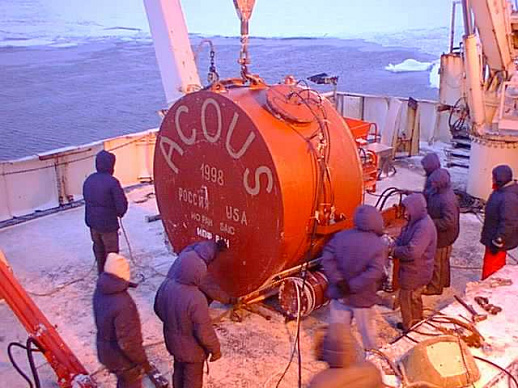Peter Mikhalevsky - peter@osg.saic.com
Brian Sperry
SAIC
1710 SAIC Drive
MCLean, VA 22102
Alexander Gavrilov
P.P. Shirshov Inst. of Oceanography
Moscow 117851, Russia
Popular version of paper 2aAO2
Presented Tuesday morning, December 3, 2002
First Pan-American/Iberian Meeting on Acoustics, Cancun, Mexico
The waters of the Arctic Ocean have been warming since the mid 1990's. Average maximum temperatures have risen by more than 1C. In the last 20 years submarine measurements of sea ice draft have shown a 40% reduction in average sea ice thickness, while satellite remote sensing has shown a 14% reduction in sea-ice extent over the same period. Current forecasts indicate that if these trends continue, the Arctic Ocean could be ice-free before the end of this century. The Arctic Ocean provides fresh water to the world's oceans, much of it in the form of sea ice discharged from the Fram Strait. This fresh water regulates convective overturning in the Greenland and Norwegian Seas, which in turn drives the global ocean thermohaline circulation (the so-called "conveyor belt") with major impact on global climate. A full understanding of the processes that are driving these changes is limited by the inadequate observational database that exists for the Arctic Ocean. Despite its major importance and the dramatic changes occurring in the Arctic Ocean today, it remains one of the most poorly sampled and poorly understood oceans in the world. We are presenting results at this conference from our work using sound propagated in the Arctic Ocean to measure its temperature, and we propose a strategy for long-term monitoring.
The speed of sound in water is directly related to the temperature of the water, and to a much lesser extent the salinity. By measuring the change in the travel time of a sound pulse between a source and a receiver we can determine the change in the average temperature along the path. In 1994 a pilot experiment was conducted in which sound was transmitted from a source deployed 300 km north of Spitzbergen to a receiver 2600 km across the Arctic Ocean at an ice camp in the Beaufort Sea. This experiment revealed that the average maximum temperature had risen by ~0.4C when compared to historical data. The 1994 experiment was part of a US/Russian joint research initiative to investigate the use of sound travel time measurements to measure the Arctic Ocean's temperature. This work continued in October 1998 with the deployment of a bottom moored acoustic source (Fig. 1), off the coast of Franz Josef Land, by the Russian icebreaker Akademik Fedorov. An acoustic receiving array was deployed 1250 km away in the Lincoln Sea. The source transmitted a 20 min acoustic signal every four days until its batteries expired in December1999. Analysis of these data, which will be reported at this meeting, showed a net increase in the average maximum temperature of water flowing into the Arctic Ocean of ~0.3C over this 14 month period. In April 1999 three of the source transmissions were measured at an ice camp 2700 km across the Arctic Ocean in the Chukchi Sea, along a path close to the 1994 measurement. This measurement showed an increase in the average maximum temperature of ~0.5C from 1994 to 1999. These acoustic measurements were consistent with submarine transects that were made across the Arctic in 1995, 1998, 1999, and 2000 using conventional temperature measuring probes. The acoustic signal takes approximately 30 min to cross the entire Arctic. A submarine takes approximately one week, at substantially greater cost!

Fig. 1 An acoustic source is deployed by the Russian icebreaker Akademik Fedorov as part of the US/Russian ACOUS (Arctic Climate Observations using Underwater Sound) Program in October 1998.
Conventional oceanographic sections to obtain ocean temperature require a submarine, an icebreaker, or a campaign of aircraft landings on the sea ice. Furthermore these measurements are generally limited to the spring through fall seasons in the Arctic as operations in the total darkness of the Arctic winter are extremely hazardous. Moorings can be deployed in the Arctic and can then provide data year-round. In the future, we envision a system of oceanographic moorings cabled to shore, and equipped to make many scientific measurements (Fig. 2). This proposed network, consisting of three moorings equipped with acoustic sources and seven equipped with acoustic receivers, would be able to "take the temperature" of the entire Arctic Ocean in less than an hour and repeat the measurement weekly on a year-round basis. Researchers would be able to access all of the data from this network over the Internet. Plans for such a network are being developed now.

Fig. 2 A proposed future monitoring network for the Arctic Ocean. This network would support wide area monitoring of Arctic Ocean temperature using acoustic measurements as well as additional oceanographic, geophysical, biological, and chemistry measurements at each of the mooring locations. This cabled network could come to shore near Alert, CA where a slant drilled sea-shore terminus already exists and at Barrow, Alaska, where a seashore terminus has been proposed.